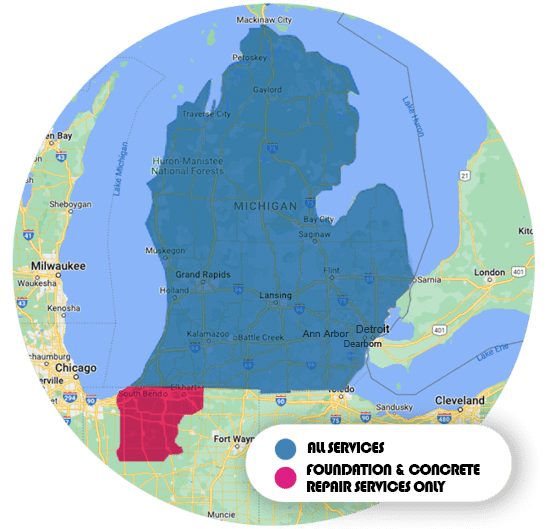
Enter your Zip Code to see if we serve your area:
Ayers Basement Systems Before & After Photos
Click on a photo to enlarge.
Securing a Bowing and Cracked Wyoming Basement Wall
Mike and Julie had a basement wall that was cracked and starting to bow so they called us for a solution. We used the CarbonArmor Wall Reinforcing System to stabilize the wall. The system is made up of flexible carbon fabric straps that are 10 times stronger in tension than steel. The straps are are then bonded to the wall using a high strength resin. This system requires no exterior excavation, installs quickly, and won't impact future basement finishing.
Stabilizing a Settling Wyoming Home
Jennifer and her family had a corner of their home that was settling and had cracks that were visible inside the home as well as outside. They wanted to sell the home but there were concerns about the cracked foundation so they called us. We used Helical Piers to not only stabilize the foundation but to also lift the foundation back up to the original position. The piers can have additional sections added to it to reach the stable soil which they anchor in. They can be installed year-round and the process is fast and effective.
Fixing Cracks with CarbonArmor in Wyoming MI
Mike noticed cracking in multiple places of his basement. He called us to fix the problem before it got worse. We installed CarbonArmor to the walls to keep them from moving even more. We chose this becuase the CarbonArmor Wall Reinforcing System is a great solution for cracking foundation walls. CarbonArmor is made up of carbon fiber fabric strips that are 10 times stronger in tension than steel. These fabric strips are bonded to the wall with a high strength epoxy resin. There is no exterior excavation involved and they are installed quickly, and they wont impact the future of basement finishing!
Fixing an Uneven Driveway and Sidewalk
Kyle had 2 slabs of concrete in the driveway and then 1 slab in the sidewalk that sank. We used PolyLevel to lift up the fallen concrete and make sure there were no hazards due to the unevenness. PolyLevel is an injected foam that raises the concrete from below and is waterproof so that it won't get washed away.
TripleSafe Sump Pump System Replaces Inefficient Sump Pump in Wyoming, MI Home
Pam was in need of a replacement for her old sump system in her basement that couldn't keep up with the heavy rains so she called Ayers. We had a crew check out her current system and from there our System Design Specialists decided TripleSafe Sump Pump System would work great. TripleSafe utilizes three pumps that fit in one sturdy liner. The second and third pumps are meant for emergency situations when backup is needed. The last pump being battery-operated for power failures. This trustworthy sump pump will ensure her basement remains dry during those heavy rains that would wreak havoc on her home before!
Our Service Area
Proudly Serving Michigan & Indiana
We serve the following areas
- Argos
- Culver
- Delong
- Donaldson
- Francesville
- Grovertown
- Hamlet
- Hanna
- Kewanna
- Kingsford Heights
- Knox
- La Crosse
- La Porte
- Lakeville
- Lapaz
- Leiters Ford
- Medaryville
- Michigan City
- Mill Creek
- Monterey
- New Carlisle
- North Judson
- North Liberty
- Ora
- Plymouth
- Rochester
- Rolling Prairie
- San Pierre
- Star City
- Tyner
- Union Mills
- Walkerton
- Wanatah
- Westville
- Winamac
- Baroda
- Berrien Springs
- Bridgman
- Buchanan
- Galien
- Harbert
- Lakeside
- New Buffalo
- New Troy
- Saint Joseph
- Sawyer
- Sodus
- Stevensville
- Three Oaks
- Union Pier


















